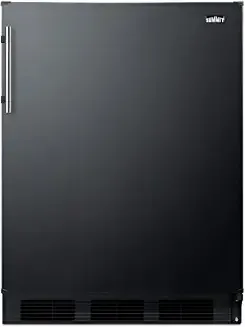
A counter-depth refrigerator is a type of appliance designed to align with the depth of standard countertops, offering a seamless, built-in appearance in your kitchen. It has become increasingly popular due to its sleek design and space-saving features. However, as with any major purchase, it is important to carefully weigh the pros and cons before committing to a counter-depth refrigerator. By examining the benefits and drawbacks, you can make a well-informed decision that best suits your individual needs, preferences, and kitchen layout.
Aesthetics
- Custom, built-in look: One of the most significant advantages of a counter-depth refrigerator is its ability to provide a custom, built-in appearance. By aligning with the depth of your countertops, it creates a cohesive and visually appealing design.
- Seamless integration with kitchen design: Counter-depth refrigerators blend seamlessly with your kitchen cabinets and countertops, offering a streamlined look that can elevate the overall aesthetic of your space.
Space-saving
- Slimmer profile: Counter-depth refrigerators have a slimmer profile compared to standard-depth models, making them an excellent choice for saving valuable floor space in your kitchen.
- Ideal for smaller kitchens or tight spaces: If you have a small kitchen or limited space, a counter-depth refrigerator can help maintain an open and uncluttered feel, making the area appear larger and more functional.
Accessibility
- Easier to reach items: The shallower depth of counter-depth refrigerators allows for easier access to items stored in the back, making it more convenient to find and retrieve food.
- Reduced likelihood of forgotten or expired food: With improved accessibility, the chances of overlooking items in the back of the fridge are reduced, leading to less food waste and fewer instances of forgotten or expired groceries.
Capacity
- Smaller storage space compared to standard-depth models: One of the main drawbacks of counter-depth refrigerators is their reduced capacity. Due to their slimmer profile, they typically offer less storage space than standard-depth models, which may be a concern for some households.
- May not be suitable for large families or extensive food storage: If you have a large family or require ample storage for groceries and meal prep, a counter-depth refrigerator might not provide the necessary space to meet your needs.
Price
- Higher cost due to specialized design and dimensions: Counter-depth refrigerators often come with a higher price tag compared to standard-depth models. This is because their sleek design and specialized dimensions can make them more expensive to produce and purchase.
Limited options
Fewer models and features to choose from: While the popularity of counter-depth refrigerators is growing, there may still be fewer models and features available compared to standard-depth refrigerators. This could potentially limit your options when searching for the perfect refrigerator to suit your preferences and requirements.
Kitchen layout and available space: Analyze your kitchen's layout and the space available for a refrigerator. Consider whether a counter-depth refrigerator will fit seamlessly with your existing cabinetry and countertops, or if adjustments will need to be made.
B. Storage needs and family size: Assess your storage requirements and the size of your household. If you have a large family or need ample storage space for groceries and meal prep, a counter-depth refrigerator may not be the most suitable choice.
C. Budget constraints: Determine your budget for a new refrigerator. Keep in mind that counter-depth models often come with a higher price tag compared to standard-depth models. It's essential to balance your desire for aesthetics and space-saving features with your financial constraints.

D. Personal preferences in design and features: Consider your personal preferences when it comes to design, style, and features. While counter-depth refrigerators offer a sleek, built-in look, there may be fewer models and features available compared to standard-depth models. Make sure to research and compare different models to find one that meets your specific needs and preferences.
When shopping for a new refrigerator, you may come across the term "counter-depth." This description often implies a sleeker, more streamlined design that is meant to blend seamlessly with your kitchen cabinetry. However, the term can be misleading as it may not always be the perfect fit for your space. Understanding the differences between counter-depth and cabinet-depth refrigerators, as well as weighing the benefits and trade-offs, will help you make an informed decision on what's best for your kitchen.
Cabinet-Depth
A cabinet-depth refrigerator is designed to align with the depth of standard kitchen cabinets, typically measuring 24 inches in depth. This results in a flush appearance and maximizes available floor space in the kitchen. However, a cabinet-depth refrigerator might not include the doors and handles in its measurements, which could still protrude beyond the cabinets.
Counter-Depth
In contrast, a counter-depth refrigerator is intended to align with your countertops, not just the cabinets. Countertop depths typically measure around 25 inches. This means that, including the doors and handles, a counter-depth refrigerator should sit flush with your counters and cabinets, creating a seamless look.
To determine if a counter-depth refrigerator is the right choice for you, it's essential to consider the benefits and trade-offs that come with this type of appliance.
The Benefits
- Aesthetics: A counter-depth refrigerator offers a built-in, custom look that can enhance the overall appearance of your kitchen.
- Space-saving: With a slimmer profile, a counter-depth refrigerator can save valuable floor space in smaller kitchens or tight spaces.
- Accessibility: The shallower depth makes it easier to reach items stored in the back of the fridge, reducing the likelihood of forgotten or expired food.
The Trade-Off
- Capacity: Counter-depth refrigerators usually have a smaller capacity compared to standard-depth models. This may not be ideal for large families or those who need ample storage space for groceries and meal prep.
- Price: Counter-depth refrigerators often come with a higher price tag due to their sleek design and specialized dimensions.
- Limited options: While the popularity of counter-depth refrigerators is growing, there may still be fewer models and features to choose from compared to standard-depth models.
Importance of evaluating pros and cons: Before investing in a counter-depth refrigerator, it is crucial to weigh the pros and cons carefully. Understanding the benefits, such as aesthetics, space-saving, and accessibility, as well as the drawbacks, like reduced capacity, higher cost, and limited options, will help you make a well-informed decision.
B. Making an informed decision based on individual needs and preferences: Ultimately, the choice of whether to purchase a counter-depth refrigerator should be based on your unique needs, preferences, and circumstances. By considering factors such as kitchen layout, storage needs, budget constraints, and design preferences, you can select the ideal refrigerator model that will enhance your kitchen's functionality and appearance.













